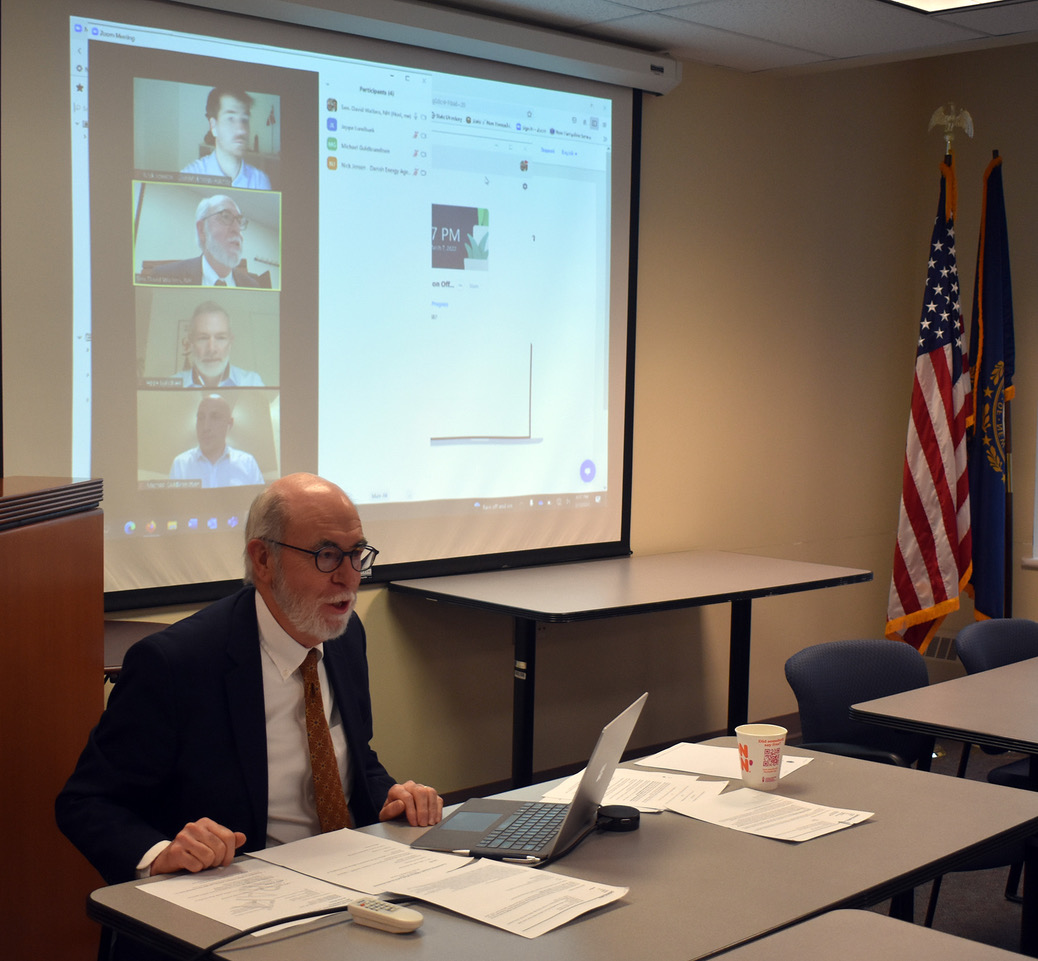By Thomas P. Caldwell, InDepthNH.org
CONCORD — Jeff Lundbaek of the Danish Wind Industry Association shared a brief history of wind power in his country and offered assistance to members of New Hampshire’s Committee To Study Offshore Wind and Port Development during a meeting on March 7 at the Walker Building.
The chair of the committee, Sen. David Watters, D-Dover, introduced the Danish guests remotely, which also included representatives from the Royal Danish Embassy in Washington, D.C. He had hoped to have them attend in person, which is why the meeting that normally takes place in Portsmouth was moved to Concord, but he noted that they still may appear before the committee at a later date.
The state is considering a memorandum of understanding with the Danish Ministry of Climate, Energy, and Utilities for cooperation on offshore wind, drawing upon that kingdom’s 50-year history in the field to help craft the Northeast’s plan for a wind farm in the Gulf of Maine.
“What is particularly useful, I think, for New Hampshire is that it brings to us expertise that we really either don’t have or don’t have very sufficiently in the state,” Watters said. “I think it’s a real opportunity, but it’s something that we have to decide if it’s right for New Hampshire.”
Watters added, “We have learned a lot, I think, over the last few weeks about the importance of democratic nations collaborating and working together, and this is the true strength of our democracy. I think we also confirmed that renewable energy provides us with an opportunity to have more control over our own energy resources.”
Denmark started its quest for alternative energy during the gasoline shortages of 1972. By 1991, Denmark began operating the world’s first wind farm and, eight years later, wind power was fully integrated into the kingdom’s energy market.
The kingdom served as the model for other nations and, by 2021, 25 countries had fully-integrated wind power operations.
Denmark currently has seven wind farms, with three more planned. The kingdom has interconnections with Norway, Sweden, Germany, and Holland, with the United Kingdom coming next. Because Norway has a large hydropower industry, Denmark is able to draw from its store of power when necessary while providing wind power to meet Norway’s needs.
Currently, renewable power accounts for 68 percent of Denmark’s electrical needs, and the country has a goal of reaching 100 percent green power by 2030.
Lundbaek emphasized the importance of what he calls “one-stop shopping” when planning green energy projects. He said that having a single regulatory agency overseeing permits can streamline the process, looking at the cost-effectiveness of each project, focusing on having them completed on time, and prequalifying companies to make sure those prone to failure do not get the contracts.
In return for the scrutiny, the companies developing the energy projects are guaranteed access to the electric grid.
Among Denmark’s successful projects is a 10 GW island in the North Sea that is totally man-made and includes a green power plant.
Lundbaek said his country wants to support offshore wind development in the United States to speed up the global move toward green energy, offering suggestions for the regulatory framework and infrastructure. He said that accelerating offshore wind in the U.S. may have trickle-down effects for Danish power — a reference to the low-cost technology that Denmark has developed over the last few decades and the investment opportunities wind power brings.
“But this is not a direct benefit program; we have no strings attached,” Lundbaek said. “We have not done anything in terms of both location and companies.”
The draft memorandum of understanding aims to “promote a mutually beneficial relationship … with a view to sharing knowledge, experiences, data, and best practices relevant to the development of offshore wind energy.”
In discussing the MOU at the end of the meeting, members of the committee said Denmark’s 30 years of experience with offshore wind could provide a lot of data, particularly in the area of its effect on marine life.
Members of the fishing industry remain opposed to offshore wind on the grounds of the impact to their livelihoods and how marine life in the Gulf of Maine would fare.
Lundbaek said the fish that scatter during construction return after a year and there appears to be no harmful effects, but there is a university study underway to provide more in-depth analysis of the impact of the wind towers. He did note that wind projects make payments to fishermen to compensate them for lost income.





